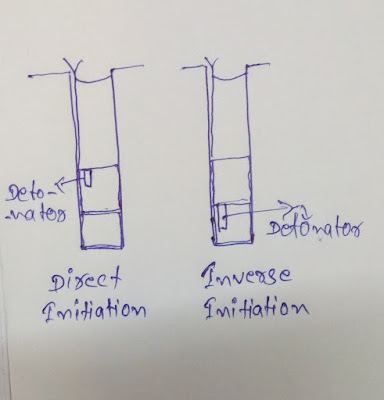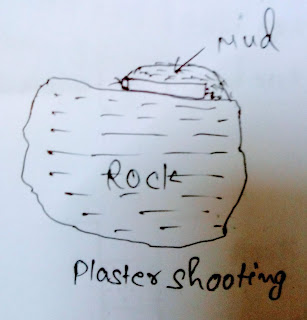Shaft Sinking
Q. What is shaft?
Ans. :- It is a vertical or inclined entry made to touch seams. The word shaft is used for underground mining entrance.
Q. Why shaft?
Ans.:- The shaft is excavated after getting approval to mine the mineral bed by underground method of mining.
Shape of Shaft
Generally the shaft are of circular in shape but in some mines it is of rectangular in shape. The circular shafts are best because they resist heavy side pressure and offers least rubbing surface area for ventilation.
Bricking and concreting job are easy and diameter of these shaft may be varies from 4.2mts to 6.7mts.
◆The shaft sinking process is costliest and time taking process. So it is necessary to drill pilot hole within the radius of 50m of main shaft which has to be drill. This pilot hole give us an idea about the rock and how we have to encounter those problem which will we face during shaft thinking. From this we will get a data about
1. Shaft site
2. Selection of water control method
3. Estimation of time and coast of shaft.
4. Design of shaft
Process of Shaft Sinking
The process of shaft sinking is the toughest work and also initial work for underground mining. The shaft sinking becomes difficult because it is restricted in area and also we have to control side pressure and underground water.
Shaft sinks at pre-decided area by excavating and walling over the surface area of the excavation. As the shaft becomes deeper the wall also covers the sides of shaft and different methods are adopted to deal with water bearing strata. After completion of shaft sinking process a complete set of headgear is installed and the shaft is ready for working.
Let's know some special method of sinking.
In some cases the ordinary method is not good to work. So we have to be adopt some special methods for the conditions as the strata may be heavily watery or of sand or mud or the combination of both the mud or sand and water.
So the special methods are here....
1. Piling System:
In this method the piles are hammered into deposited of sand, mud, or alluvium soil up to a depth of 20mts. So, the method is also called piling or sheet piling method. The sheet piles are water tight and it's length is 6m to 10m.
The arrangement of piles of interlocking System. At the surface a ring is formed of piles and they are hammered down.
When the piles reaches the strong rock, a permanent lining is constructed. After that the sinking process is proceeds by normal process.
2. Caisson Method
This method is also involves three other methods and these are here
¡.Open caisson Method
In this method a drum of m.s ring having steel cutting shoes is allowed to sink in the cylindrical well and bricking is done at the of 0.3m to .4m in thickness. The drum sinks down due it's own weight. Sometimes additional load is placed and care must be taken to for the drum that is going vertically or not.
¡¡. Forced drop shaft method
In this method the cast iron drum refuses to sink in shaft due to friction.
Further the method is carried by the application of external source of force by hydraulic ram. High friction is introduced due to the alternative tough and loose ground and the working depth up to 60mts.
¡¡¡. Pneumatic caisson
This method is adopted where it is danger of filling of shaft by ground or the inrush of water. So the compressed air of up to 4kg/cm square is used and 1.2 to 2m above the the shoe compressed keep back the water and sand. The limitation of depth is not more than 30m.
3. Frozen Method
This method is adopted where there is chance of heavy inrush of water or sand. So it is necessary to froze the ground to prevent inrush of water in to shaft.
At first we have drill holes of 150mm dia. of 2.2 to 3m of interval. This is done around the shaft. The holes after drilling lined with special tube and it is important that the holes are in vertical.
Now, inside holes a special tube is inserted with cold brine. This cold brine makes a wall of sufficient size around the shaft and further shaft sinking is processes normally.
After the work completed, the cold brine is removed by inserting hot brine.
Cementation Process
We can say that this process is a universal process of shaft sinking. This method is successful even when the inrush of water is heavy but this method has limitations for sand or loose ground.
The ground around the shaft have to treat to achieve aspects
1. Stability
2. Inflow of water
3. Avoid flooding
4. To prevent sand boiling
Cementation is necessary work to achieve humidity and corrosion free environment.
By drilling holes the slurry of water and cement is injected till the they are completely sealed. Previous the pressure was 6kgf/cm square but now 300khf/cm square can be successfully used.
After the cementation the process proceeds as usual manner.
Ans. :- It is a vertical or inclined entry made to touch seams. The word shaft is used for underground mining entrance.
Q. Why shaft?
Ans.:- The shaft is excavated after getting approval to mine the mineral bed by underground method of mining.
 |
| Simple View of Working Shaft |
Shape of Shaft
Generally the shaft are of circular in shape but in some mines it is of rectangular in shape. The circular shafts are best because they resist heavy side pressure and offers least rubbing surface area for ventilation.
Bricking and concreting job are easy and diameter of these shaft may be varies from 4.2mts to 6.7mts.
◆The shaft sinking process is costliest and time taking process. So it is necessary to drill pilot hole within the radius of 50m of main shaft which has to be drill. This pilot hole give us an idea about the rock and how we have to encounter those problem which will we face during shaft thinking. From this we will get a data about
1. Shaft site
2. Selection of water control method
3. Estimation of time and coast of shaft.
4. Design of shaft
Process of Shaft Sinking
The process of shaft sinking is the toughest work and also initial work for underground mining. The shaft sinking becomes difficult because it is restricted in area and also we have to control side pressure and underground water.
Shaft sinks at pre-decided area by excavating and walling over the surface area of the excavation. As the shaft becomes deeper the wall also covers the sides of shaft and different methods are adopted to deal with water bearing strata. After completion of shaft sinking process a complete set of headgear is installed and the shaft is ready for working.
Let's know some special method of sinking.
In some cases the ordinary method is not good to work. So we have to be adopt some special methods for the conditions as the strata may be heavily watery or of sand or mud or the combination of both the mud or sand and water.
So the special methods are here....
1. Piling System:
 |
In this method the piles are hammered into deposited of sand, mud, or alluvium soil up to a depth of 20mts. So, the method is also called piling or sheet piling method. The sheet piles are water tight and it's length is 6m to 10m.
The arrangement of piles of interlocking System. At the surface a ring is formed of piles and they are hammered down.
When the piles reaches the strong rock, a permanent lining is constructed. After that the sinking process is proceeds by normal process.
2. Caisson Method
This method is also involves three other methods and these are here
¡.Open caisson Method
In this method a drum of m.s ring having steel cutting shoes is allowed to sink in the cylindrical well and bricking is done at the of 0.3m to .4m in thickness. The drum sinks down due it's own weight. Sometimes additional load is placed and care must be taken to for the drum that is going vertically or not.
¡¡. Forced drop shaft method
In this method the cast iron drum refuses to sink in shaft due to friction.
Further the method is carried by the application of external source of force by hydraulic ram. High friction is introduced due to the alternative tough and loose ground and the working depth up to 60mts.
¡¡¡. Pneumatic caisson
This method is adopted where it is danger of filling of shaft by ground or the inrush of water. So the compressed air of up to 4kg/cm square is used and 1.2 to 2m above the the shoe compressed keep back the water and sand. The limitation of depth is not more than 30m.
3. Frozen Method
This method is adopted where there is chance of heavy inrush of water or sand. So it is necessary to froze the ground to prevent inrush of water in to shaft.
At first we have drill holes of 150mm dia. of 2.2 to 3m of interval. This is done around the shaft. The holes after drilling lined with special tube and it is important that the holes are in vertical.
Now, inside holes a special tube is inserted with cold brine. This cold brine makes a wall of sufficient size around the shaft and further shaft sinking is processes normally.
After the work completed, the cold brine is removed by inserting hot brine.
Cementation Process
We can say that this process is a universal process of shaft sinking. This method is successful even when the inrush of water is heavy but this method has limitations for sand or loose ground.
The ground around the shaft have to treat to achieve aspects
1. Stability
2. Inflow of water
3. Avoid flooding
4. To prevent sand boiling
Cementation is necessary work to achieve humidity and corrosion free environment.
By drilling holes the slurry of water and cement is injected till the they are completely sealed. Previous the pressure was 6kgf/cm square but now 300khf/cm square can be successfully used.
After the cementation the process proceeds as usual manner.




Comments
Post a Comment